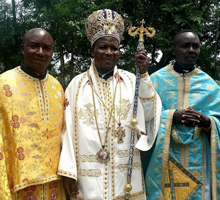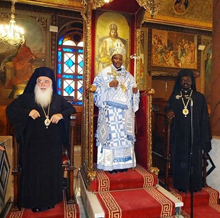The Vulnerable and Poor, Whose Hope is in God Alone
 On the Successes and Difficulties of Mission Work in Africa
On the Successes and Difficulties of Mission Work in Africa
It was recently reported that His Grace Bishop Athanasius of Kisumu and Western Kenya of the Patriarchate of Alexandria fell seriously ill about a month ago and is in the ICU at St. Vincent Hospital in Worcester, MA. The news has spread quickly around social networks, and many have offered prayers and fond stories of Bp. Athanasius and the personal holiness they sense in him. Angel Karadakov, the founder of one of the most popular Bulgarian Orthodox websites, Dobrotuliuie, conducted a short interview with His Grace about five weeks ago, just before he fell ill, and Angel has graciously offered us the English text of the interview to publish.
Your Eminence, how long have you been part of the Alexandria Orthodox Church and have you always been in Kenya?
I have been part of the Alexandria Church my whole life, from the age of eight. Now I’m forty-seven. After Kenya, I went to Holy Cross [Seminary in Boston—OC] for studies, and by then I was serving as a deacon. After four years in the U.S., I was sent by the late Patriarch Petros VII to begin a new mission to Africans in South Africa. I stayed for fourteen years before I was recalled by my Patriarch to Kenya, where I taught in the seminary for two months before I was elected as a bishop. In South Africa, I was very close to the Serbian community in Johannesburg. That’s why I know a lot about Serbia and still have close relationships there. I have been to Greece, especially to monasteries, including especially the Monastery of the Theotokos in Peristeri where I’m a member of the brotherhood.
Have you kept statistics over the years on how many people have accepted Orthodoxy and how many churches and monasteries there are, not only in Kenya but in all of Africa?
Kenya has a total of 1 million Orthodox Christians. That’s the smallest fraction in Kenya compared to other denominations but the biggest among the Orthodox in Africa. That’s why Kenya has been divided into three dioceses—for easier administration.
In my diocese alone I have 70,000 active Christians with 120 priests and 600 churches.
 Monasteries have been a challenge in Kenya. We had one more than twenty years ago but it was closed. After three years as a bishop we have two active monasteries in my diocese, including one for men named for St. Anthony. We bought the land but haven’t built yet, so we are renting a space for our three novices now. By the way, I’ve asked if we can have our monks go to Serbia to train.
Monasteries have been a challenge in Kenya. We had one more than twenty years ago but it was closed. After three years as a bishop we have two active monasteries in my diocese, including one for men named for St. Anthony. We bought the land but haven’t built yet, so we are renting a space for our three novices now. By the way, I’ve asked if we can have our monks go to Serbia to train.
We have also opened the Convent of St. Cleopatra with four seasoned nuns and three African novices. We have the land but we have not built due to finances, but we are using one of the diocesan houses as a chapel, where the nuns are staying on a temporary basis. We may have other monasteries in the future, but for now, there’re only two active monasteries in the diocese of Kisumu.
Before the faithful accept Orthodoxy, do they attend Church-organized courses?
Before our believers are baptized they attend classes taught mainly by catechists, who are graduates from the seminary who have not been ordained yet.
What difficulties do you encounter in your pastoral work in Kenya?
There are many difficulties, including material needs, because we have so many poor people. In Africa, you cannot separate missions from philanthropy because, just as in Galilee, most of the those who are ready to listen to the Gospel message are vulnerable and poor people whose hope is in God alone.
Another challenge is the flood of other faiths that makes it difficult to spread Orthodoxy. Also, we have to compromise between African culture and Orthodoxy.
How is Orthodoxy accepted in Africa, for instance among other religious communities?
Orthodoxy is widely accepted in Africa and many of its practices resonate with traditional African practices and beliefs.
Orthodoxy was never associated with the colonial powers, with its own suffering in Orthodox countries like Cyprus under the British, Greece under the Turks, and so on. This history unites Africans with Orthodoxy.
Thank you for your time, Your Grace. We would be glad if you would send us further news or information about your work in Kenya, because have a great interest in Christianity in Africa here in Bulgaria.
Biographical information provided by Bp. Athanasius:
I was born in the remote village of Ebukhubi, which is predominantly Protestant. I was one of the first Orthodox in the area after my parents converted around 1980. I went to ACK Elementary School, Mill Hill Catholic High School, and Makarios III Orthodox Seminary in Kenya, where I graduated with a Diploma in Theology.
I was ordained as a deacon in 1998 and was sent to Holy Cross Greek Orthodox Seminary in Bostin in 2002. I was ordained as a priest after moving to South Africa through the blessing of the late Pope and Patriarch Petros and Archbishop Seraphim then of Johannesburg and Pretoria.
 I was the head of missions in the diocese and the dean of the Petros VII Seminary in South Africa. I graduated with a doctorate in missions, focusing on the dialogue between Orthodoxy and African culture from the State University of South Africa.
I was the head of missions in the diocese and the dean of the Petros VII Seminary in South Africa. I graduated with a doctorate in missions, focusing on the dialogue between Orthodoxy and African culture from the State University of South Africa.
I was made an archimandrite on January 18, 2010 by Archbishop Damaskinos of Johannesburg and Pretoria. In 2015, by the blessings of His Beatitude Pope and Patriarch of Alexandria Theodoros II, I was recalled to teach at Makarios III Seminary.
On November 24, 2015, the new Diocese of Kisumu and All Western Kenya was created by the Holy Synod. I was elected its first bishop on the same day and consecrated in Alexandria by Pope and Patriarch of Alexandria and All Africa Theodoros II on the feast day of St. Nicholas, December 6, 2015. I was enthroned, again by Pope and Patriach Theodoros II, on May 15, 2016 at St. Andrew Gimengwa in Kisumu.

